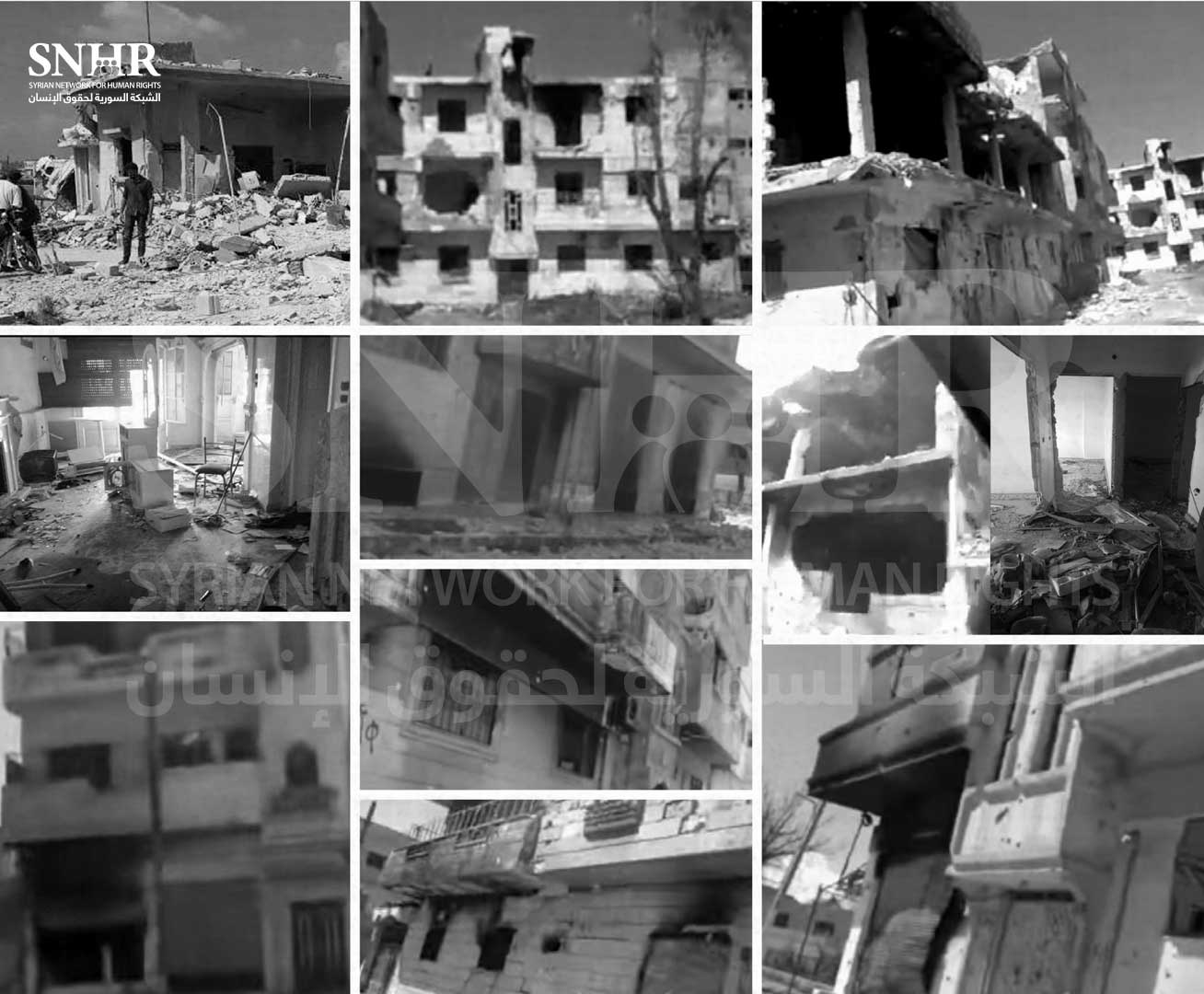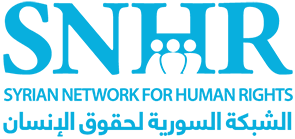A Calculated Policy of Destruction Put in Motion by the Syrian Regime to Seize Homes, Properties and Areas of Land Through an Unlawful Quasilegal System

Languages
Available In
Press Release (Download the full report below)
The Hague – The Syrian Network for Human Rights (SNHR) today released a report entitled, “The Mechanisms by Which the Syrian Regime Has Used Laws to Expropriate Tens of Thousands of Homes, Properties and Areas of Land in Homs Governorate”, in which the group tries to break down the Syrian regime’s calculated policies to seize homes, properties, and areas of land through an unlawful quasilegal system.
The report is divided into two main sections, with each section being further subdivided into a number of chapters and research questions. The first section of this report, which focuses on ‘How the lives of Homs residents and their properties have been affected by them joining the uprising’, aims to briefly summarize Homs governorate’s involvement in the Syrian uprising and give a sense of its historical trajectory. To that end, it was important to also give a brief summary of the Syrian regime’s barbaric response to the peaceful demands of the Syrian people, as the report outlines the most notable gross violations perpetrated by the Syrian regime in the 12-plus years since the beginning of the uprising in March 2011, as well as the destruction left by the regime in Homs governorate. The second section tackles two case studies – Baba Amr neighborhood in Homs city and al-Qsair city in rural Homs. By taking one area of the city and another of rural Homs, the report tried to expand its scope of focus into both the city and rural areas in Homs governorate. As the report tackles both cases, the most notable violations and destruction taking place in both Baba Amr and al-Qsair are examined, in an attempt to track how that affected the process of forced displacement of the residents of the governorate, which set the stage for the regime to seize real estate properties.
The report adopts an investigative approach, according to which all the accounts, interactive maps, documentative photos, and video footage were exhaustively analyzed in order to arrive at informed conclusions, with a specific focus on the development of the situation on the ground. To that end, the report includes a small survey of the hundreds of Syrian citizens that SNHR interviewed from across Homs governorate and whose real estate properties have been affected and violated by the regime’s practices. As for the interactive maps, which includes satellite imagery, the report incorporates the criteria applied by the United Nations Satellite Center (UNOSAT) of the United Nations Institute for Training and Research (UNITAR).
The report stresses that, in the last five years since 2018, the Syrian regime intensified its efforts to seize citizens’ property and deprive them of their housing, land, and property rights (HLP) on the basis of laws and decrees it has unlawfully promulgated since 2011, taking advantage of the chaotic climate of an internal armed conflict, as well as exploiting its absolute control of the People’s Assembly of Syria. The regime has worked for years on building this quasilegal arsenal over the course of the internal armed conflict. The report adds that, while the laws and decrees put in place by the Syrian regime can potentially be used to target the properties of any Syrian, they are primarily and directly targeting three groups: First: The forcibly displaced (namely internally displaced persons ‘IDPs’ and refugees), currently numbering approximately 12 million Syrian citizens according to the UN Refugees Agency (UNHCR); second: forcibly disappeared persons, currently numbering approximately 112,713 Syrian citizens; and third: Approximately 500,000 Syrians killed since 2011 (both civilians and military combatants), the overwhelming majority of whose deaths have not been documented in the civil registry’s records. As it is widely established, most of those are regime dissidents and have been victims of the regime violations being committed since March 2011.
As the report further notes, there is a clear and firm connection between human rights violations and HLP violations, since gross human rights violations naturally drives people to flee, thereby making their properties subject to expropriation in accordance with the legals texts promulgated by the Syrian regime. In this context, the report outlines the most notable violations that forced people to flee. As such, the report notes that no fewer than 30,571 civilians were killed at the hands of the parties to the conflict and controlling forces in Homs between March 2011 and August 2023. The report also documented no fewer than 20 massacres exhibiting a sectarian character. Most of these massacres were committed in the early years of the uprising. Moreover, the report records that, of the people arrested between March 2011 and September 2023, 7,374 individuals are still detained and/or forcibly disappeared at the hands of the parties to the conflict and controlling forces in Homs governorate. The overwhelming majority of these violations have been perpetrated by the Syrian regime and its allies.
Meanwhile, the report records that no fewer than 3,636 barrel bombs have been dropped by the regime air force on Homs governorate since July 2012 up until August 2023, killing 708 civilians. The report also document seven chemical attacks at least taking place in Homs governorate since the first documented use of chemical weapons on December 23, 2012, up until August 2023. All of the seven attacks were carried out by Syrian regime forces. Additionally, the report records no fewer than 18 cluster munition attacks since the first documented use of cluster munitions in Syria in July 2012, up until August 2023, which resulted in the killing of no fewer than six civilians. Finally, the report documents the killing of 110 civilians in Homs governorate by the explosion of landmines between March 2011 and August 2023.
The report sheds light on two case studies in Homs governorate – Baba Amr neighborhood and al-Qsair city. To that end, the report outlines the most notable violations in both areas, while tracking the seizure of real estate properties owned by the Syrians and giving an idea of the scope of destruction taking place in Baba Amr and al-Qsair. Additionally, the report conducts a comparison between the destruction captured by satellite imagery and the actual destruction on the ground, in order to give further insight into the scope of pillage and seizure targeting lands and real estate properties, and the true size of destruction seen in many cities, villages, and neighborhoods across the governorate of Homs.
The report concludes that the maps indicate that the artillery and aerial attacks against many cities, neighborhood, and rural areas in Homs governorate was too excessive in relation to the anticipated military benefit for the regime or its allies in the ground, which suggests that these attacks had no military purpose, but were carried out for the sake of other goals, such as destroying and seizing the real estate properties of Syrian citizens by driving their owners out and then eliminating any possibility of them ever returning, which paves the way for the regime to take advantage of the properties and lands it seized for the sake of the reconstruction process. This has been the ultimate end goal pursued by the regime regardless of the violation it has committed, the severe material losses it has caused, or the fact that it has impoverished the Syrian people by seizing their properties and lands.
The report calls on the international community and the UN to condemn the Syrian regime’s hegemony over the three branches of government, to expose its practices in passing laws which are simply quasi-legal tools used to pillage the properties of IDPs, refugees, forcibly disappeared persons, and unregistered victims, in the hopes of repealing the future effects of these laws, which is one of the report’s most important objectives.
Furthermore, the report calls on donor states, investors, and humanitarian agencies operating in Syria to cease their direction of funds to the Syrian regime through reconstruction programs, and to introduce new mechanisms, so as to avoid those funds potentially being misused to violate the HLP rights of residents or the displaced, or so that these funds do not go to bodies that violate human rights and international humanitarian law.
The report also calls on the UNHCR to condemn the practices of the Syrian regime that involve widespread and systematic looting and taking control of the properties and the residential and agricultural lands owned by refugees and IDPs, and submit a report to the Security Council and the UN Special Envoy to Syria on this issue, since this is one of the main obstacles impeding the return of refugees and IDPs. The report adds that the UNHCR should reiterate that it is not possible to talk about a potential normalization of relations with the Syrian regime without first resolving the issue of refugees, which cannot be resolved without fully and wholly return real estate rights to their original owners in Syria, in addition to making other recommendations…


